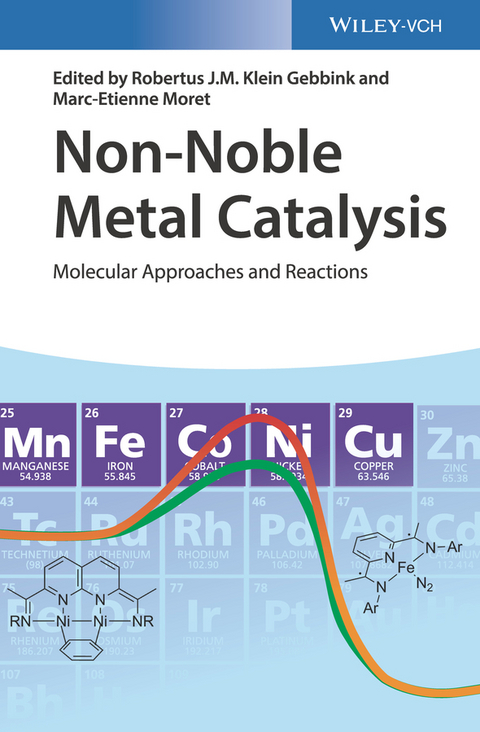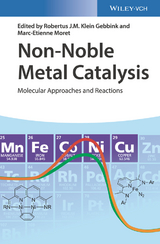Non-Noble Metal Catalysis
Wiley-VCH (Verlag)
978-3-527-34061-3 (ISBN)
- Titel ist leider vergriffen;
keine Neuauflage - Artikel merken
Bert Klein Gebbink, PhD, is full professor at Utrecht University, The Netherlands. His current research interests include homogeneous catalysis, organometallic chemistry, and bioinorganic chemistry, with a specific focus on iron-based catalysis, the immobilization of homogeneous catalysts and the catalytic conversion of biomass into chemical building blocks. Marc-Etienne Moret, MSc, is assistant professor at Utrecht University, The Netherlands. His research interests lie in the organometallic chemistry of base metals with the aim of using these cheap, nontoxic metals to promote (in)organic transformations of environmental / industrial significance.
Preface
APPLICATION OF STIMULI-RESPONSIVE AND "NON-INNOCENT" LIGANDS IN BASE METAL CATALYSIS
Introduction
Stimuli-Responsive Ligands
Redox-Active Ligands as Electron Reservoirs
Cooperative Ligands
Substrate Radicals in Catalysis
Summary and Conclusions
COMPUTATIONAL INSIGHTS INTO CHEMICAL REACTIVITY AND ROAD TO CATALYST DESIGN: THE PARADIGM OF CO2 HYDROGENATION
Introduction
Reaction Energetics and Governing Factor
Newly Designed Catalysts and Their Reactivity
Correlation Between Hydricity and Reactivity
Concluding Remarks
CATALYSIS WITH MULTINUCLEAR COMPLEXES
Introduction
Stoichiometric Reaction Pathways
Application in Catalysis
Polynuclear Complexes
Outlook
COPPER-CATALYZED HYDROGENATIONS AND AEROBIC N-N BOND FORMATIONS: ACADEMIC DEVELOPMENTS AND INDUSTRIAL RELEVANCE
Introduction
Cu-Promoted N-N Bond Formation
Cu-Catalyzed Homogeneous Hydrogenation
Conclusions
C=C HYDROGENATIONS WITH IRON GROUP METAL CATALYSTS
Introduction
Iron
Cobalt
Nickel
Conclusion
BASE METAL-CATALYZED ADDITION REACTIONS ACROSS C-C MULTIPLE BONDS
Introduction
Catalytic Addition to Alkenes Initiated Through Radical Mechanism
Other Catalytic Additions to Unsaturated Bonds Proceeding Through Initial R· (R¿H) Attack
Catalytic Addition to Alkenes Initiated Through Polar Mechanisms
Hydrosilylation Reactions
Conclusion
IRON-CATALYZED CYCLOPROPANATION OF ALKENES BY CARBENE TRANSFER REACTIONS
Introduction
Achiral Iron Porphyrin Catalysts
Iron Phthalocyanines and Corroles
Iron Catalystswith N or N,OLigands
The [Cp(CO)2FeII(THF)]BF4 Catalyst
Conclusions
NOVEL SUBSTRATES AND NUCLEOPHILES IN ASYMMETRIC COPPER-CATALYZED CONJUGATE ADDITION REACTIONS
Introduction
Catalytic Asymmetric Conjugate Additions to Alpha-Substituted Alpha,Beta-Unsaturated Carbonyl Compounds
Catalytic Asymmetric Conjugate Additions to Alkenyl-Heteroarenes
Conclusion
ASYMMETRIC REDUCTION OF POLAR DOUBLE BONDS
Introduction
Manganese
Iron
Cobalt
Nickel
Copper
Conclusion
IRON-, COBALT-, AND MANGANESE-CATALYZED HYDROSILYLATION OF CARBONYL COMPOUNDS AND CARBON DIOXIDE
Introduction
Hydrosilylation of Aldehydes and Ketones
Reduction of Imines and Reductive Amination of Carbonyl Compounds
Reduction of Carboxylic Acid Derivatives
Hydroelementation of Carbon Dioxide
Conclusion
REACTIVE INTERMEDIATES AND MECHANISM IN IRON-CATALYZED CROSS-COUPLING
Introduction
Cross-Coupling Catalyzed by Simple Iron Salts
TMEDA in Iron-Catalyzed Cross-Coupling
NHCs in Iron-Catalyzed Cross-Coupling
Phosphines in Iron-Catalyzed Cross-Coupling
Future Outlook
RECENT ADVANCES IN COBALT-CATALYZED CROSS-COUPLING REACTIONS
Introduction
Cobalt-Catalyzed C-C Coupling Through a C-H Activation Approach
Cobalt-Catalyzed C-C Couplings Using a Preactivated Substrate Approach (Aryl Halides and Pseudohalides)
Cobalt-Catalyzed C-X Couplings Using C-H Activation Approaches
Cobalt-Catalyzed C-X Couplings Using a Preactivated Substrate Approach (Aryl Halides and Pseudohalides)
Miscellaneous
Conclusions and Future Prospects
TRIFLUOROMETHYLATION AND RELATED REACTIONS
Trifluoromethylation Reactions
Trifluoromethylthiolation Reactions
Perfluoroalkylation Reactions
Conclusion
CATALYTIC OXYGENATION OF C=C AND C-H BONDS
Introduction
Oxygenation of C=C Bonds
Oxygenation of C-H Bonds
Conclusions and Outlook
ORGANOMETALLIC CHELATION-ASSISTED C-H FUNCTIONALIZATION
Introduction
C-C Bond Formation via C-H Activation
C-Heteroatom Formation via C-H Activation
Conclusions
CATALYTIC WATER OXIDATION: WATER OXIDATION TO O2 MEDIATED BY 3D TRANSITION METAL COMPLEXES
Water Oxidation - From Insights into Fundamental Chemical Concepts to Future Solar Fuels
ModelWell-DefinedWater Oxidation Catalysts
Conclusion and Outlook
BASE-METAL-CATALYZED HYDROGEN GENERATION FROM CARBON- AND BORON NITROGEN-BASED SUBSTRATES
Introduction
Hydrogen Generation from Formic Acid
Hydrogen Generation from Alcohols
Hydrogen Storage in Liquid Organic Hydrogen Carriers
Dehydrogenation of Ammonia Borane and Amine Boranes
Conclusion
MOLECULAR CATALYSTS FOR PROTON REDUCTION BASED ON NON-NOBLE METALS
Introduction
Iron and Nickel Catalysts
Other Non-Noble Metal-Based Catalysts: Co, Mn, Cu, Mo, and W
Conclusion
NONREDUCTIVE REACTIONS OF CO2 MEDIATED BY COBALT CATALYSTS: CYCLIC AND POLYCARBONATES
Introduction
Cocatalysts for CO2/Epoxide Couplings: Salen-Based Systems
Co-Porphyrins as Catalysts for Epoxide/CO2 Coupling
Cocatalysts Based on Other N4-Ligated and Related Systems
Aminophenoxide-Based Co Complexes
Conclusion and Outlook
DINITROGEN REDUCTION
Introduction
Activation of N2
Reduction of N2 to Ammonia
Reduction of N2 to Silylamines
Conclusions and Outlook
Index
| Erscheinungsdatum | 20.02.2019 |
|---|---|
| Verlagsort | Berlin |
| Sprache | englisch |
| Maße | 170 x 244 mm |
| Gewicht | 1320 g |
| Themenwelt | Naturwissenschaften ► Chemie ► Physikalische Chemie |
| Schlagworte | catalysis • Chemie • Chemistry • Industrial Chemistry • Katalyse • Nachhaltige u. Grüne Chemie • Pharmaceutical & Medicinal Chemistry • Pharmazeutische u. Medizinische Chemie • Sustainable Chemistry & Green Chemistry • Sustainable Chemistry & Green Chemistry • Technische u. Industrielle Chemie |
| ISBN-10 | 3-527-34061-0 / 3527340610 |
| ISBN-13 | 978-3-527-34061-3 / 9783527340613 |
| Zustand | Neuware |
| Informationen gemäß Produktsicherheitsverordnung (GPSR) | |
| Haben Sie eine Frage zum Produkt? |
aus dem Bereich




